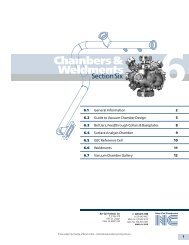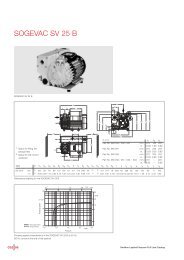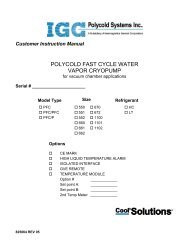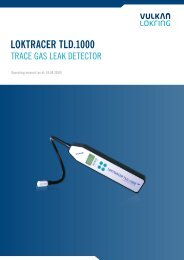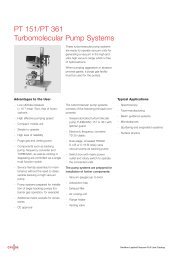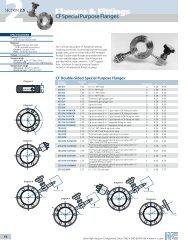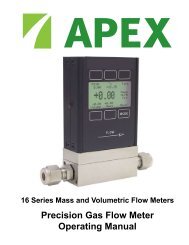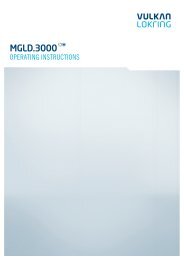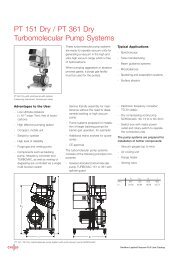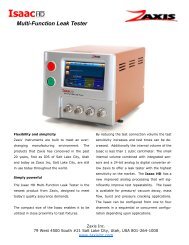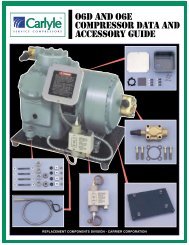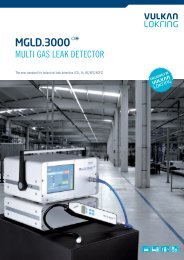B2 - Schoonover, Inc.
B2 - Schoonover, Inc.
B2 - Schoonover, Inc.
Create successful ePaper yourself
Turn your PDF publications into a flip-book with our unique Google optimized e-Paper software.
Leak Detectors<br />
Leak Detection Methods<br />
Integral Method<br />
3<br />
Fig 3<br />
LD<br />
HELIUM<br />
5<br />
1<br />
2<br />
Local Leak Detection with<br />
Leak Detectors – Sniffing<br />
The test object is filled with the search gas or the search gas/air mixture to<br />
which the leak detector is sensitive. The leak detector is equipped with a<br />
sniffer probe, whereby there is a low pressure at the probe tip. If the sniffer<br />
tip passes suspicious points on the test object the search gas coming out of<br />
the leak is sucked in and transferred to the detection system of the leak<br />
detector. After conversion into electrical signals these are displayed<br />
optically and acoustically by the leak detector.<br />
Integral Method – Hood Test<br />
4<br />
Integral method Ð Evacuated test object<br />
5<br />
1<br />
Key to the Figures<br />
1 Test object, 2 Leak detector, 3 Search gas cylinder , 4 Vacuum pump,<br />
5 Hood, 6 Spray gun for search gas , 7 Sniffer probe<br />
3<br />
7<br />
Determination of the total leak rate of a test object. The testing arrangement<br />
is the same as for local leak detection, but in this case the test object is not<br />
sprayed with search gas on selected areas, but it is surrounded by a hood<br />
or a chamber which is filled with the search gas. Thus the entire outer<br />
surface of the test object comes into contact with the search gas.<br />
If the search gas enters the test object, the total leak rate is indicated<br />
independently of the number of existing leaks. With helium leak detectors it<br />
is possible to determine the helium content of the air. This is utilized in the<br />
detection of gross leaks.<br />
Leak Testing Based on<br />
Overpressure Methods<br />
(Overpressure within the test object)<br />
Pressure Drop Method<br />
The test object is filled with a gas (for example air or nitrogen) until the<br />
testing pressure is reached. Precision vacuum gauges are used to detect a<br />
possible pressure drop during the testing period. This method is simple to<br />
implement, it is suitable for the determination of gross leaks and can be<br />
improved upon by using differential pressure gauges. By applying soap<br />
solutions or similar, leaks can be located.<br />
2<br />
LD<br />
HELIUM<br />
Integral method (search gas accumulation)<br />
Search gas overpressure in the test object<br />
To determine the total leak rate of a test object subjected to a search gas<br />
overpressure, the test object is surrounded by a hood of a known volume.<br />
The search gas which escapes through the leaks collects in the hood.<br />
After a fixed accumulation period a sniffer probe is used to measure the<br />
concentration of the search gas which has collected in the hood. Before this<br />
the leak detector should be calibrated by a reference measurement using a<br />
known search gas concentration.<br />
The leak rate can then be determined by the equation for q L<br />
where V is the<br />
volume of the hood, ∆p is the partial pressure difference of the search gas<br />
(concentration change) and t is the accumulation period.<br />
Uncertainties in the determination of the volume, leaks in the hood and a<br />
wrong accumulation period make precise leak rate measurements based on<br />
this method very questionable.<br />
Integral Method – Vacuum Hood Test<br />
1<br />
3<br />
5<br />
1<br />
3<br />
7<br />
LD<br />
HELIUM<br />
2<br />
2<br />
LD<br />
HELIUM<br />
4<br />
Leak detection Ð Search gas overpressure in the test object<br />
Integral method Ð Search gas overpressure in the test object<br />
B5.6




